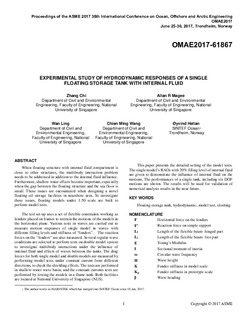| dc.contributor.author | Chi, Zhang | |
| dc.contributor.author | Magee, Allan R. | |
| dc.contributor.author | Ling, Wan | |
| dc.contributor.author | Wang, Chen Ming | |
| dc.contributor.author | Hellan, Øyvind | |
| dc.date.accessioned | 2017-11-21T07:25:03Z | |
| dc.date.available | 2017-11-21T07:25:03Z | |
| dc.date.created | 2017-11-16T12:52:53Z | |
| dc.date.issued | 2017-06-25 | |
| dc.identifier.citation | ASME 2017 36th International Conference on Ocean, Offshore and Arctic Engineering - Volume 7A: Ocean Engineering | nb_NO |
| dc.identifier.isbn | 978-0-7918-5773-1 | |
| dc.identifier.uri | http://hdl.handle.net/11250/2467237 | |
| dc.description.abstract | When floating structure with internal fluid compartment is close to other structures, the multibody interaction problem needs to be addressed in addition to the internal fluid influence. Furthermore, shallow water effects become important, especially when the gap between the floating structure and the sea floor is small. These issues are encountered when designing a novel floating oil storage facilities in nearshore area. To investigate these issues, floating models under 1:50 scale are built to perform model tests. The test set-up uses a set of flexible constraints working as fenders placed on frames to restrain the motions of the models in the horizontal plane. Various tests in waves are carried out to measure motion responses of single model in waves with different filling levels and stiffness of “fenders”. The reaction forces on the “fenders” are also measured. Several regular wave conditions are selected to perform tests on double model system to investigate multibody interactions under the influence of internal fluid and effects of waves between the tanks. The drag forces for both single model and double models are measured by performing model tests under constant current from different directions, to check the shielding effects. The tests are performed in shallow-water wave basin, and the constant currents tests are performed by towing the models in a flume tank. Both facilities are located at National University of Singapore (NUS). This paper presents the detailed setting of the model tests. The single model’s RAOs with 20% filling level of internal fluid are given to demonstrate the influence of internal fluid on the motions. The performances of a single tank, including six DOF motions are shown. The results will be used for validation of numerical analysis results in the near future. | nb_NO |
| dc.language.iso | eng | nb_NO |
| dc.publisher | ASME Proceedings | Ocean Engineering | nb_NO |
| dc.relation.ispartof | ASME 2017 36th International Conference on Ocean, Offshore and Arctic Engineering - Volume 7A: Ocean Engineering | |
| dc.relation.ispartofseries | ASME Digital colletion;OMAE2017-61867 | |
| dc.rights | Navngivelse-Ikkekommersiell-DelPåSammeVilkår 4.0 Internasjonal | * |
| dc.rights.uri | http://creativecommons.org/licenses/by-nc-sa/4.0/deed.no | * |
| dc.subject | Fluids | nb_NO |
| dc.subject | Storage tanks | nb_NO |
| dc.title | Experimental Study of Hydrodynamic Responses of a Single Floating Storage Tank With Internal Fluid | nb_NO |
| dc.type | Chapter | nb_NO |
| dc.description.version | acceptedVersion | nb_NO |
| dc.rights.holder | the authors | nb_NO |
| dc.identifier.doi | 10.1115/OMAE2017-61867 | |
| dc.identifier.cristin | 1514834 | |
| cristin.unitcode | 7566,9,0,0 | |
| cristin.unitname | Hydrodynamikk | |
| cristin.ispublished | true | |
| cristin.fulltext | postprint | |
| cristin.qualitycode | 1 | |

